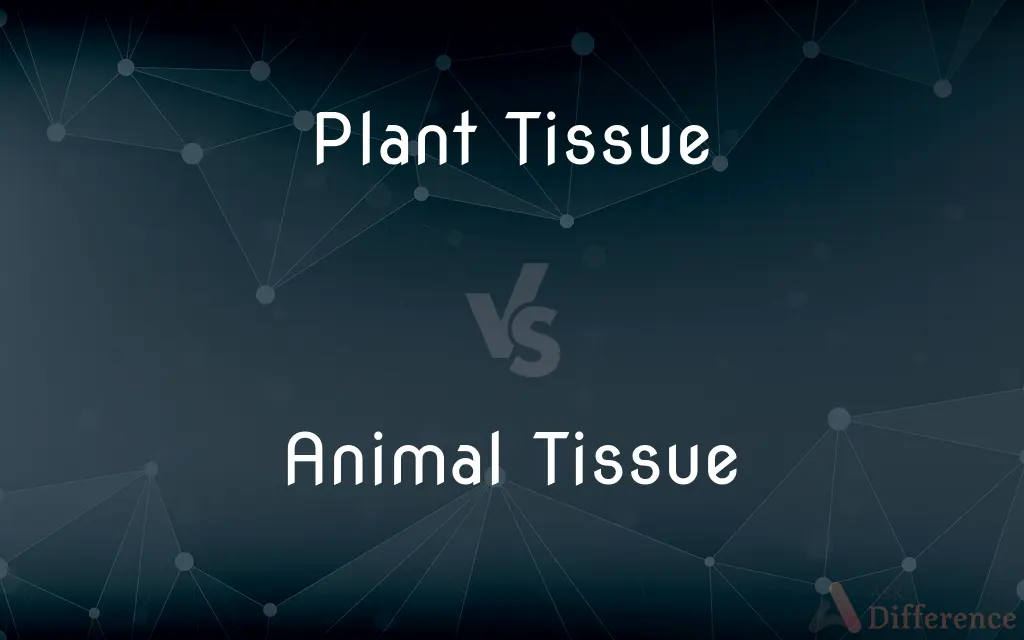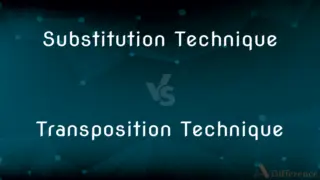Plant Tissue vs. Animal Tissue — What's the Difference?
By Tayyaba Rehman — Published on January 8, 2024
Plant tissues are specialized cells organized in plants for various functions, while animal tissues form the structural and functional units in animals.

Difference Between Plant Tissue and Animal Tissue
Table of Contents
ADVERTISEMENT
Key Differences
Plant tissues are specialized groupings of cells found in plants. These cells work collectively to perform specific functions necessary for the plant's growth, support, and reproduction. In contrast, animal tissues comprise cells that come together to execute particular roles within animal bodies, aiding in their survival, reproduction, and daily functions.
Differentiating further, plant tissues can be broadly classified into meristematic and permanent tissues. Meristematic tissues are responsible for the plant's growth, while permanent tissues offer support. Animal tissues, on the other hand, are classified into various types such as epithelial, connective, muscular, and nervous tissues. Each of these animal tissues has specific functions ranging from protection to movement and coordination.
Plant tissues like the epidermis provide a protective barrier, and xylem and phloem manage nutrient and water transportation. Animal tissues, however, present a broader diversity in function. For example, epithelial tissue in animals protects body surfaces, and muscular tissue helps in movement.
Plant tissues often contain chloroplasts, enabling them to perform photosynthesis, a process exclusive to plants. Animal tissues do not have such structures and instead rely on various mechanisms like digestion to obtain energy. In essence, while both plant and animal tissues serve as organized structures for function, their roles, composition, and capabilities diverge significantly due to the inherent differences in plant and animal life.
Comparison Chart
Primary Function
Photosynthesis, support, growth
Movement, protection, sensory reception, coordination
ADVERTISEMENT
Cell Wall
Present, mainly composed of cellulose
Absent
Types
Meristematic, permanent (e.g., epidermis, xylem)
Epithelial, connective, muscular, nervous
Energy Generation
Through photosynthesis in chloroplasts
Through digestion and cellular respiration
Cell Vacuoles
Large central vacuole
Small or absent
Compare with Definitions
Plant Tissue
Some plant tissues play roles in photosynthesis and support.
Chloroplast-rich mesophyll cells are crucial plant tissues for photosynthesis.
Animal Tissue
Some animal tissues aid in sensory reception and coordination.
Nervous tissue in animals helps in transmitting signals.
Plant Tissue
Plant tissues provide structural integrity and aid in nutrient transport.
The phloem plant tissue helps in distributing food.
Animal Tissue
Animal tissues can vary based on texture, elasticity, and function.
The epithelial animal tissue covers body surfaces.
Plant Tissue
Plant tissues can be differentiated based on location and function.
The epidermis is an external plant tissue offering protection.
Animal Tissue
Animal tissues can be voluntary or involuntary based on control.
Cardiac tissue, an animal tissue, functions involuntarily.
Plant Tissue
Plant tissues can be actively growing or permanent.
Meristematic tissue in plants aids in growth.
Animal Tissue
Animal tissues are groups of cells in animals that carry out specialized functions.
Muscular tissue in animals is responsible for movement.
Plant Tissue
Plant tissues are cellular organizations in plants that perform specific functions.
The xylem is a plant tissue responsible for transporting water.
Animal Tissue
Animal tissues offer protection, support, and motion capabilities.
Connective tissue provides support and binds other tissues.
Common Curiosities
How do animal tissues differ from plant tissues?
Animal tissues provide functions like movement and protection, while plant tissues focus on photosynthesis and support.
Do plant tissues have a cell wall?
Yes, plant tissues have a cell wall mainly composed of cellulose.
What is the primary function of xylem in plants?
Xylem, a plant tissue, is responsible for transporting water.
Can animal tissues produce their own food?
No, animal tissues rely on digestion to obtain nutrients.
Do animal tissues have chloroplasts?
No, chloroplasts are absent in animal tissues.
What is the role of epithelial tissue in animals?
Epithelial animal tissue covers and protects body surfaces.
What are plant tissues?
Plant tissues are specialized cell groupings in plants that execute specific functions.
Can plant tissues perform photosynthesis?
Yes, certain plant tissues with chloroplasts can perform photosynthesis.
What's the role of nervous tissue in animals?
Nervous tissue in animals helps in transmitting signals and coordination.
Which animal tissue aids in movement?
Muscular tissue in animals helps in movement.
Do animal tissues have a cell wall?
No, animal tissues do not have a cell wall.
Which plant tissue aids in growth?
Meristematic tissue in plants aids in growth.
Which tissue in plants offers protection?
The epidermis is a plant tissue that offers protection.
How do animal tissues obtain energy?
Animal tissues obtain energy through digestion and cellular respiration.
Are chloroplasts found in all plant tissues?
No, chloroplasts are primarily found in plant tissues involved in photosynthesis.
Share Your Discovery

Previous Comparison
Brother Printer vs. HP Printer
Next Comparison
Substitution Technique vs. Transposition TechniqueAuthor Spotlight
Written by
Tayyaba RehmanTayyaba Rehman is a distinguished writer, currently serving as a primary contributor to askdifference.com. As a researcher in semantics and etymology, Tayyaba's passion for the complexity of languages and their distinctions has found a perfect home on the platform. Tayyaba delves into the intricacies of language, distinguishing between commonly confused words and phrases, thereby providing clarity for readers worldwide.














































